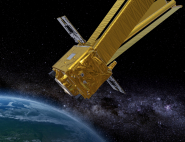Galileo centre stage (1971)
In a vacuum, does one kilogram of feathers fall more quickly or slowly than one kilogram of lead? A video from the Moon gives us the answer.
Whether Galileo performed the experiment from the top of the Tower of Pisa or not is not important: he had a good understanding of the phenomenon of falling bodies and he proposed to verify it experimentally using various techniques. But let us return to what he wrote about falling bodies.
“We propose to seek what would happen to falling bodies of very different weights in a medium completely devoid of resistance. If we find that the difference in speed depends on the capability to penetrate, and that for very unequal weights in an extremely empty medium although not in a vacuum, the variation in velocity is very small and virtually imperceptible, then we could admit with a very great probability, that velocities would be equal in vacuum".
Obviously, Galileo did not have the technical means to pursue his programme.
In tribute to Galileo, the astronaut David Scott performed "Galileo's experiment" during the Apollo 15 mission, in July 1971. He dropped a feather and a hammer from the same height on the Moon and they hit the lunar surface at the same time. While this experiment was not quantitative, it paved the way for similar experiments no longer on the Moon, but in drop towers.

